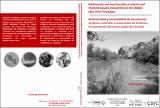Por favor, use este identificador para citar o enlazar a este item:
http://hdl.handle.net/10261/128381COMPARTIR / EXPORTAR:
 SHARE
BASE SHARE
BASE
|
|
| Visualizar otros formatos: MARC | Dublin Core | RDF | ORE | MODS | METS | DIDL | DATACITE | |

| Título: | Biodiversity and functionality of natural and restored aquatic ecosystems in the Middle Ebro River floodplain |
Otros títulos: | Biodiversidad y funcionalidad de ecosistemas acuáticos naturales y restaurados de la llanura de inundación del tramo medio del río Ebro | Autor: | Español Latorre, Cecilia | Director: | Comín, Francisco A. CSIC ORCID | Fecha de publicación: | nov-2015 | Resumen: | [EN] Results obtained in the current PhD dissertation demonstrate the effectivity, at least in the short-to-medium term, of ecological restoration to improve the structure and functionality of degraded floodplains. The 61% of the studied structural indicators and 89% of the functional indicators recovered and even improved after floodplain restoration. This fact was associated to lower water eutrophication and turbidity, and higher substratum and vegetation diversity of the restored in comparison to non-restored ecosystems. Specifically, constructed wetlands showed significantly higher abundance and richness of macroinvertebrates than degraded natural wetlands. Besides, the macroinverterbate community showed more diversity of functional traits related to reproduction, dispersion and feeding habits in constructed wetlands than in degraded natural wetlands. The rapid recovery in aquatic communities contrasts with the poor rates of net ecosystem production in constructed wetlands in comparison to those recorded in degraded natural wetlands, seven times lower. Differences between wetlands were more evident at the pelagic level, observation mainly associated to the low nutrient content and organic matter accumulation of constructed wetlands. Conditions that in turn, are one of the main reasons of the lower methane emission rates in constructed wetlands in comparison to the emissions of degraded natural wetlands, registering values four times lower. As for the groundwater ecosystem, floodplain areas occupied by riparian forest showed higher abundance, taxonomic diversity and functional diversity in their alluvial aquifer than areas occupied by agricultural uses. Additionally, biogeochemical filtration and particulate organic matter breakdown capacities also increased under natural forest land. In conclusion, outcomes of the current PhD dissertation demonstrate the suitability of ecological restoration as a management strategy for the conservation and improvement of the biodiversity and functionality of floodplains of large regulated Mediterranean rivers. Moreover, we highlight the importance of considering both structural and functional aspects in all steps of a floodplain restoration project to optimize its long-term effectiveness, so as to provide and support key species and functions in the ecosystem and, consequently, maximize the ecosystems services provided by floodplains. | Descripción: | 232 páginas.- Tesis presentada para optar al grado de Doctor por la Universidad San Jorge de Zaragoza | URI: | http://hdl.handle.net/10261/128381 |
| Aparece en las colecciones: | (IPE) Tesis |
Ficheros en este ítem:
| Fichero | Descripción | Tamaño | Formato | |
|---|---|---|---|---|
| Tesis_doctoral_CEspanol_2015.pdf | 16,51 MB | Adobe PDF |  Visualizar/Abrir |
CORE Recommender
Page view(s)
292
checked on 18-abr-2024
Download(s)
750
checked on 18-abr-2024
Google ScholarTM
Check
NOTA: Los ítems de Digital.CSIC están protegidos por copyright, con todos los derechos reservados, a menos que se indique lo contrario.
